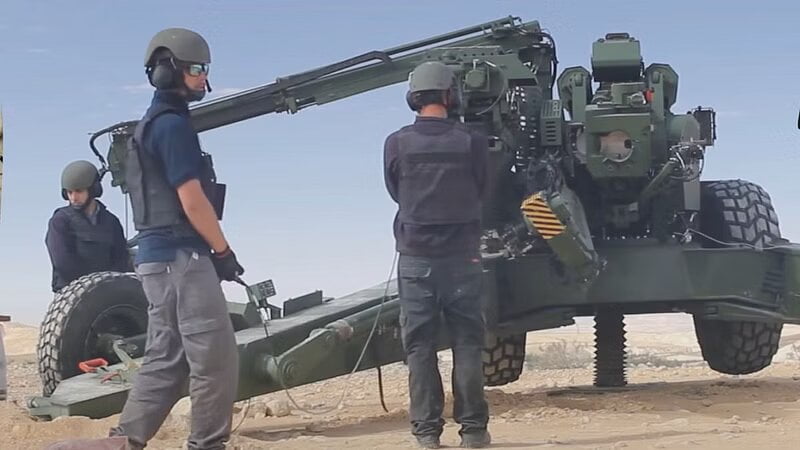The Indian Army has sent out a new Request for Information (RFI) to get a 155mm/52 calibre towed gun system. This is part of a plan from 1999 to modernise artillery regiments.
But the RFI opens a new door for the Israeli company Elbit, whose Autonomous Towed Howitzer Ordnance System (ATHOS) was in the running for a big contract with the Indian Army for more than a decade.
This is happening at the same time that Indian companies Kalyani Group and TATA are working with the Defence Research and Development Organisation (DRDO) to make the Advanced Towed Artillery Gun System (ATAGS), which was used for the Independence Day ceremony firing at the Red Fort.
The RFI, which was sent out on December 20, says that the gun system’s weight “should be less than 15 tonnes if possible.” And because of this clause, the Israeli company that has a partnership with Adani Group is back in the running to sell the ATHOS to the Indian Army.
Since the ATHOS weighs less than 15 tonnes and the ATAGS weighs well over 18 tonnes, the new RFI could be a chance for the Israeli weapon system.
The 155mm x 52 calibre towed artillery gun was on the first list of things that couldn’t be brought in for defence. The ban was supposed to start in December 2020, but the cut-off date for this type of gun was moved to December 2021.
But a rule was made that said the military could import defence equipment even if it was on a list of things that couldn’t be brought in.
The Israeli gun was put on the negative list because the DRDO was working on a version of the towed 155 mm/52 calibre howitzer (ATAGS) that was made in India.
The history of ATHOS
As part of the Army’s 1999 Field Artillery Rationalisation Plan, the process of getting towed guns started in 2001.
Since then, several requests for proposals (RFPs) have been sent out. Elbit and France’s Nexter took part in the last RFP sent out by the UPA government.
The deal was for the supply of 400 guns and for the Ordnance Factory Board (OFB) to make the other 1,180 guns in India. This is called a full transfer of technology (TOT) process.
RFIs are used to get information about goods or services from suppliers, while RFPs are used to get bids for a project during a bidding process.
In March 2019, Elbit Systems was named the lowest bidder after what was meant to be a thorough “Field Trial Cum Evaluation Process” that took place over several years and had many ups and downs (L1).
But the DRDO said that it was against any plans to import, saying that ATAGS is better than ATHOS and is the gun of the future.
The Army, which supports the ATAGS programme, asked for 400 of these guns (enough for 20 regiments) to be bought from Elbit to “fill operational gaps in medium artillery in high altitude areas along the northern borders,” citing tensions at the Line of Actual Control (LAC).
The Israeli company wrote to the Ministry of Defense to say that if it wanted to buy only the first 400 towed guns, the cost of TOT could be taken out of the total price of the contract.
In the letter, Elbit Systems said that India could choose to buy for the future 1,180 guns for the same price as the commercial offer.
Elbit also said that it has finished figuring out how to get 70% of the first 400 towed guns to be made in Israel. This will start with the first set of guns.
It said that the ATHOS was made to meet the specific needs of the Indian Army. It also said that it had spent tens of millions of dollars on designing and developing the gun to meet Army needs and testing it in the field.
The defence sources said that Elbit also promised to deliver the guns much sooner than when the contract said they would. The first six guns would be delivered 10 months after the contract was signed, and the other six would be delivered 14 months after that.
All of the remaining guns were supposed to be delivered no later than 54 months after the contract was signed, instead of the 72 months that were written into the draught contract.
Elbit told the Indian defence establishment that the ATHOS will be an Indian gun in the end because it will be mass-produced, put together, and integrated in India.
After bidding much less than the French gunmaker Nexter in a government tender to give the Indian Army 1,580 artillery guns, the Israeli company Elbit Systems wrote to Defence Minister Rajnath Singh and said it would build 70% of the guns in India.
This is far more indigenisation than the 50% necessary for ‘Make in India’ initiatives.
Elbit Systems must supply the first 400 of its ATHOS 155 mm, 52-calibre towed artillery guns in either a fully built or knocked-down state. There are no requirements for the guns to be made in Israel.
At least half of the remaining 1,180 guns that the Ordnance Factory Board has to make must be made in India. Elbit will give them the technology they need to do this.
Elbit’s letter goes way beyond what was asked for.
‘We would like to confirm that Elbit Systems is committed to manufacture the ATHOS towed gun system in India, strictly and in full compliance of the ‘Make in India’ policy, with 70 per cent indigenisation (Indian value) within the contract of the first 400 towed guns,’ it says.
